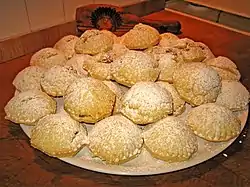Ma'amoul
Maamoul (Arabic: معمول maʿmūl [mæʕˈmuːl]) is a filled butter cookie made with semolina flour. The filling can be made with dried fruits like figs or dates or nuts such as pistachios or walnuts and occasionally almonds.[1]
 | |
| Type | Dessert |
|---|---|
| Region or state | Arab world |
| Main ingredients | Semolina, dates, pistachios or walnuts |

Maamoul are usually made during the Easter holiday, Purim, and a few days before Eid (then stored to be served with Arabic coffee and chocolate to guests who come during the holiday).[1][2] It is popular throughout the Arab world,[3] especially in the Arabian peninsula.[4]
They may be in the shape of balls, domed or flattened cookies. They can either be decorated by hand or be made in special wooden moulds called tabe.[5]
Variations
The cookies can be filled with nuts (commonly used nuts are pistachios, almonds or walnuts) or dried fruits, most commonly orange-scented date paste.[6]
In Turkey, maamouls are referred to as Kombe and the filling usually consists of crushed walnuts, ginger and cinnamon.[7]
Etymology
The Arabic word (معمول maʿmūl [mæʕˈmuːl]) is derived from the Arabic verb ʿamala (عمل, meaning "to do").[8]
Customs
While ma'amoul are consumed all-year long, they are most associated with Eid Al-Fitr or iftar as meals in celebration for the ending of Ramadan's fasting.[9] For Christian Arabs as well, ma'amoul is also part of the Easter celebrations.[5]
See also
References
- "Maamoul: An Ancient Cookie That Ushers In Easter And Eid In The Middle East". NPR.org. Retrieved 2017-11-10.
- "Maamoul: The Sweet Tradition of Eid". The Irresistible Magazine by Al Rifai. 7 September 2016. Archived from the original on 4 April 2019. Retrieved 11 November 2017.
- Obayda, Gloria. Sweets And Desserts Of The Middle East. 101 Middle Eastern Delights.
- "At the Immigrant's Table: Jewish ma'amoul pie". At the Immigrant's Table. 3 February 2014. Archived from the original on 14 April 2019. Retrieved 11 November 2017.
- Helou, Anissa (2015). Sweet Middle East: Classic Recipes, from Baklava to Fig Ice Cream.
- Goldstein, Joyce (2002). Saffron Shores: Jewish Cooking of the Southern Mediterranean. Chronicle Books. p. 169. ISBN 9780811830522.
- Warren, Ozlem. "Tag: variations of ma'amoul". Ozlem's Turkish Table. Retrieved 2021-12-20.
- Team, Almaany. "Definition and meaning of the verb in Arabic language - Arabic dictionary - Page 1". www.almaany.com.
- Holidays of the World Cookbook for Students, 2nd Edition. ABC-CLIO. 2011. p. 383. ISBN 9780313383946.
Further reading
- Farah, Madelain, Lebanese Cuisine: More than 200 Simple, Delicious, Authentic Recipes: London: 2001 ISBN 978-1-56858-179-8
- Smouha, Patricia, Middle Eastern Cooking, London 1955 ASIN: B0000CJAHX
- Roden, Claudia, A New Book of Middle Eastern Food: London 1986 ISBN 0-14-046588-X
- Roden, Claudia, The Book of Jewish Food: New York 1997, London 1999 ISBN 0-14-046609-6
- Uvezian, Sonia, Recipes and Remembrances from an Eastern Mediterranean Kitchen: A Culinary Journey Through Syria, Lebanon, and Jordan: 2004 ISBN 0-9709716-8-0, ISBN 978-0-9709716-8-5
- Joan Nathan, The Jewish Holiday Kitchen: New York 1988 ISBN 0-8052-0900-X
- Joan Nathan's Jewish Holiday Cookbook: 2004 ISBN 0-8052-4217-1, ISBN 978-0-8052-4217-1
External links
- "Maamoul – Traditional Middle Eastern Cookies". www.libanaissweets.com. Retrieved 10 November 2015.